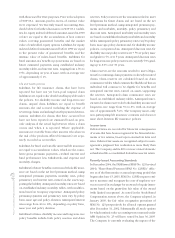American Express 2004 Annual Report Download - page 89
Download and view the complete annual report
Please find page 89 of the 2004 American Express annual report below. You can navigate through the pages in the report by either clicking on the pages listed below, or by using the keyword search tool below to find specific information within the annual report.
assumptions used by management do not prevail, loss
experience could differ significantly, resulting in either
higher or lower future provisions for losses, as applicable.
International banking
International banking loans at AEB primarily represent
amounts due from consumers, high net worth individu-
als, banks and other institutions, and corporations.
Consumer and private banking loans include unse-
cured lines of credit, installment loans, mortgage loans
and auto loans to retail customers as well as secured
lending to high net worth individuals. Loans to banks
and other institutions represent trade-related financing
and other extensions of credit. Corporate loans repre-
sent commercial and industrial loans as well as mort-
gage and real estate loans to corporate customers.
International banking loans at AEB are stated at the
principal amount outstanding net of unearned income
and are presented on the balance sheet net of reserves
for losses which are discussed below.
Reserve for losses — international banking
For smaller-balance consumer loans, management estab-
lishes reserves it believes to be adequate to absorb losses
inherent in the portfolio. Generally, these loans are
written-off in full when an impairment is determined or
when the loan becomes 120 or 180 days past due,
depending on loan type. Loans, other than smaller-
balance consumer loans (including loans impaired under
SFAS No. 114, “Accounting by Creditors for Impairment
of a Loan”), are placed on nonperforming status when
payments of principal or interest are 90 days past due or
if, in management’s opinion, the borrower is unlikely to
meet its contractual obligations. The allowance for
impaired loans is measured as the excess of the loan’s
recorded investment over either the present value of
expected principal and interest payments discounted at
the loan’s effective interest rate or, if more practical for
collateral dependent loans, the fair value of collateral. For
floating rate impaired loans, the effective interest rate is
fixed at the rate in effect at the date the impairment criteria
are met.
Other loans
Other loans primarily represent installment loans,
revolving credit due from TRS and AEFA customers,
AEFA policyholder loans and interest-bearing
advances to airline partners. Interest-bearing advances
to airline partners will be reduced by mileage credits
purchased from these partners through 2008.
Asset securitizations
The Company periodically securitizes cardmember
receivables and loans. Securitization of the Company’s
cardmember receivables and loans is accomplished
through the transfer of those assets to a special purpose
entity created for the securitization, generally a trust,
which in turn issues securities that are collateralized by
the transferred assets to third-party investors. The Com-
pany accounts for its transfers of financial assets in
accordance with SFAS No. 140. In order for a securitiza-
tion of financial assets to be accounted for as a sale
under SFAS No. 140, the transferor must surrender con-
trol over those financial assets to the extent that consid-
eration other than beneficial interests in the transferred
assets is received in exchange. Cardmember loans are
transferred to a qualifying special purpose entity, and
such transactions are structured to meet the sales criteria
of SFAS No. 140. Accordingly, when loans are sold
through securitizations, the Company removes the loans
from its consolidated balance sheets and recognizes
both a gain on sale and the retained interests in the secu-
ritization.
Cardmember receivables are transferred to a special
purpose entity that does not meet the requirements for
treatment as a qualifying sale under SFAS No. 140.
Therefore, securitizations of cardmember receivables
are accounted for as secured borrowings in accordance
with SFAS No. 140. The Company has securitized card-
member receivables totaling $1.9 billion and $3.0 billion
as of December 31, 2004 and 2003, respectively, which
are included in cardmember receivables on the Consoli-
dated Balance Sheets as they do not qualify for off-
balance sheet treatment under SFAS No. 140; likewise,
an equal amount of debt is included in long-term debt.
Separate account assets and liabilities
Separate account assets and liabilities are funds held for
the exclusive benefit of variable annuity and variable
life insurance contractholders. The Company receives
investment management fees, mortality and expense
risk fees, minimum death benefit guarantee fees and
cost of insurance charges from the related accounts.
Deferred acquisition costs
Deferred acquisition costs (DAC) represent the costs of
acquiring new business, principally direct sales commis-
sions and other distribution and underwriting costs that
have been deferred on the sale of annuity, life and health
insurance and, to a lesser extent, property/casualty and
certain mutual fund products. For annuity and insurance
products, DAC are amortized over periods approximat-
ing the lives of the business, generally as a percentage of
AXP
AR.04
87
Notes to Consolidated Financial Statements
























